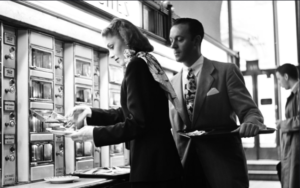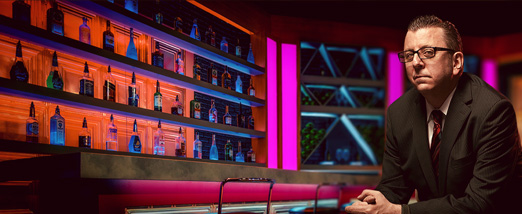THE AUTOMAT: 4 STARS. “quickly paced, interesting and affectionate documentary.”
 A new documentary, “The Automat,” directed by Lisa Hurwitz and now playing in theatres, is a evocative look back when you could get a square meal for a round quarter.
A new documentary, “The Automat,” directed by Lisa Hurwitz and now playing in theatres, is a evocative look back when you could get a square meal for a round quarter.
For more than fifty years Horn & Hardart automats fed more Americans than any other restaurant chain. For the price of a nickel you could get a cup of strong coffee, poured from a spout shaped like a dolphin. The rest of the menu was housed behind small doors with windows that displayed the wares, like baked beans, chicken pot pies, creamed spinach or Secretary of State Colin Powell’s favorite, the macaroni and cheese. Pop a coin in the slot, open the door and lunch or dinner is served.
“The Automat” uses talking heads, like Mel Brooks, Ruth Bader Ginsburg and Elliott Gould, and archival footage to create a nostalgic look at a by-gone institution but to also contextualize the contributions the quirky restaurants made to American society.
A precursor to fast food chains like Burger King or Arby’s, both of whom would later fall under the Horn & Hardart umbrella, the automats were a sensation. The first Horn & Hardart automat opened in 1902 in Philadelphia with a strict adherence to quality and egalitarianism. For the next 89 years—the last New York Horn & Hardart Automat closed in April 1991—everyone was welcome with no racial barrier, tables were shared by strangers and, at their heyday in the 1940s and 50s, they served upwards of 350,000 customers a day in New York alone.
Everyone interviewed raves about the food and the restaurants. Starbucks CEO Howard Schultz talks about how a visit to Horn & Hardart sparked his love of the hospitality business, and how it influences him today. Powell remembers family outings and the delicious pies that were a once-a-week treat.
As glowing as the interviews are, there is often a sense of nostalgic melancholy about the demise the automat—a victim of changing times—as an example of how the good ol’ days, represented by the elegant and welcoming restaurants, are truly behind us.
“It had some style and it was different,” says self-serve automat superfan Mel Brooks. “The marble, the brass, the polished floors, the chatter, the coffee. That was the Automat. It can’t work again because the logistics and economics of today won’t allow anything that simple, naive, elegant and beautiful to flourish again.”
“The Automat” is a quickly paced, interesting and affectionate populist documentary that brings to life how, for a time, happiness could be bought for the price of a cheap cup o’ joe.
